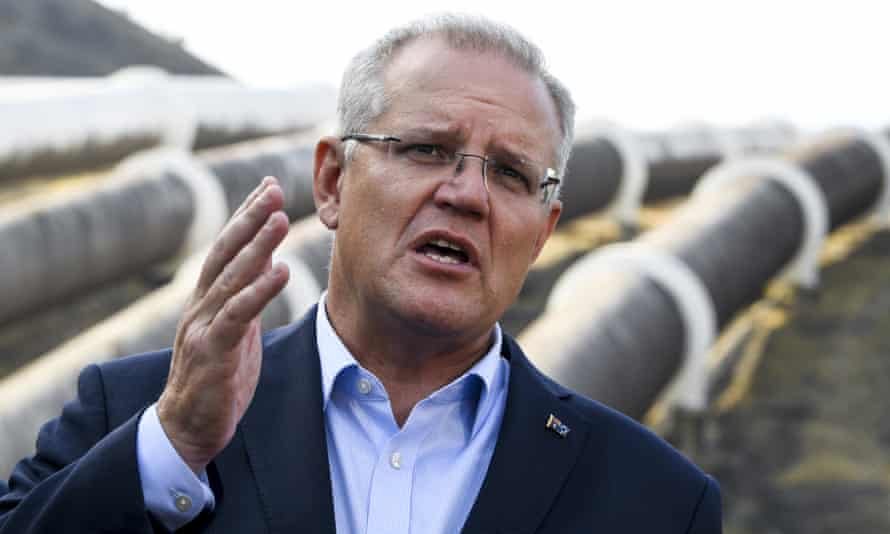Emission pledges by states put extra pressure on Scott Morrison to lift national climate goals
Experts say state and territory commitments put net zero within reach whereas the federal target is nowhere near it

Last modified on Wed 29 Sep 2021 13.32 EDT
Australian states could deliver at least a 34% cut in national greenhouse gas emissions by 2030 based on existing pledges, prompting calls for the Morrison government to lift its climate goals.
New South Wales on Wednesday became the third state to set a target of cutting emissions roughly in half by the end of the decade compared with 2005 levels, in line with what scientists say is necessary for the developed world to live up to the goals of the Paris agreement.
NSW and South Australia have both set targets to reduce emissions by 50% by 2030, while Victoria has set a 45-50% range. The biggest emitting state, Queensland, has a 30% target.
If all were to meet their goals and other states and territories kept emissions at 2019 levels, Australia would comfortably surpass the Morrison government’s target of a 26-28% cut, reaching at least 34%. The national cut would be deeper if Western Australia and the Northern Territory set targets to reverse significant rises in their emissions over the past 15 years – up 21% and 47% respectively before Covid-19 hit – due to expanding fossil fuel developments.
Analysts contrasted the commitment by the NSW Coalition with its federal counterpart, which remains divided over whether to adopt a net zero emissions target for 2050 or increase its 2030 goal before the Cop26 climate conference in Glasgow in a month.
Bill Hare, chief executive and senior scientist with Climate Analytics, said it would “clearly put a lot of pressure on the Morrison government”, which has not introduced policies to significantly reduce emissions from electricity, industry or transport.
“It shows the majority of Australians support doing more than the federal government,” Hare said.
He said all states needed to do more to play their part in the world limiting global heating to 1.5C, but it was “a good start”.
“It does put getting to net zero by 2050 within striking distance, whereas the national target is nowhere near it,” he said.
Morrison signalled to a group of metropolitan Liberals during a private briefing on Tuesday that he wanted to reach an agreement with the National party before the Glasgow summit that included both a policy roadmap setting out a technological approach to emissions reduction, and a mid-century target.
But some in the National party remain opposed. The Queensland National Llew O’Brien told Guardian Australia: “Until I see a plan that guarantees no increased cost of living pressures for regional Australians and businesses, energy reliability for domestic and commercial energy users and does not negatively affect resources industry jobs – both direct and indirect – I’m not in support of signing onto a net carbon neutral by 2050 agreement.”
Ken O’Dowd, who holds the Queensland seat of Flynn, said net zero was not a big issue in his electorate. He said it was “really a question for industry, not politicians” because private operators would ultimately make the transition. “It is really industry we need to consult with to see what we should be doing,” O’Dowd said. “We have got a big discussion on our hands, and we have to consider things like nuclear energy as part of that discussion.”
Quick GuideHow to get the latest news from Guardian AustraliaShow

Email: sign up for our daily morning briefing newsletter
App: download the free app and never miss the biggest stories, or get our weekend edition for a curated selection of the week’s best stories
Social: follow us on YouTube, Facebook, Instagram, Twitter or TikTok
Podcast: listen to our daily episodes on Apple Podcasts, Spotify or search “Full Story” in your favourite app
The more ambitious NSW commitment was based on updated emissions projections that suggested it was already on track to achieve a 47-52% emissions cut by 2030. It coincided with a report by the Beyond Zero Emissions thinktank that suggested green export industries could be worth triple the value of today’s fossil fuels by 2050 if the country acted swiftly.
Matt Kean, the NSW energy and environment minister, told rightwing broadcaster Sky News that Matt Canavan and others who cited the price of coal on global markets as a reason for Australia not to cut emissions were “not living in the real world”, citing the case of Kodak, which crashed after failing to capitalise on the hunger for digital photography.
Hare said the state government had recognised that acting on the climate crisis was now about grasping the opportunity to create industries that would thrive in a low-emissions world, and not be left behind. “I think that’s a very strong message that’s really resonating,” he said.
He said it would also put pressure on other states. “Any suggestion in Western Australia of a 2030 target that has emissions above its 2005 levels would be rightly viewed as completely unfair,” he said.
Rebecca Mikula-Wright, the chief executive of the Investor Group on Climate Change, said the eastern state pledges aligned with changes under way on global capital markets, putting those jurisdictions in line with “our major trading partners in the G20, including the US, Japan, Canada and the European Union“.
“The emerging gap between Australia’s current national 2030 emissions targets and mainstream global investor practice, and company commitments to action, is a concern to institutional investors,” she said.
The former prime minister Malcolm Turnbull criticised Morrison on Wednesday for saying he was yet to make up his mind on whether he would attend the Glasgow conference. Turnbull said he intended to go to the conference to pursue his interest in green hydrogen and the prime minister’s absence would “send a strong message about his priorities”. “History is made by those who turn up,” he said.
Industry group the Clean Energy Council called on the government to include a target for Australia to be running entirely on renewable energy and storage by 2030 as part of any roadmap to be released before the Glasgow meeting. Its chief executive, Kane Thornton, said that alone would cut national emissions by 44% by 2030.
“Decarbonising the electricity sector is the most efficient pathway to net zero by 2050, so the sooner we get it done, the sooner we can focus on the areas of the economy that can take advantage of our low-cost zero-emissions electricity,” he said.